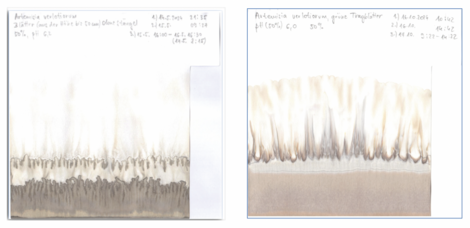Vesna Forštnerič Lesjak
In July 2024, I began a new rising picture project, as project manager, that will focus primarily on pharmaceutical issues over the next five years. Quality is considered to be the most important principle in the field of anthroposophical medicine, but thus far, it can only be proven scientifically to a limited extent. In addition to important analytical studies on efficacy, a basis for the quality characteristics of medicinal products must also be created and documented. In the case of herbal medicines, this concerns what is referred to in anthroposophy as the anabolic life and the catabolic astral and which are reflected physically and physiologically in the primary and secondary metabolic system of the plant. These can be traced qualitatively fairly well with the rising picture method.
My goal is to “harness the creative power of plants”[1] in their efficacy comparatively over the course of the year, as well as their change through the aqueous pharmaceutical processes. Initially, six known medicinal Artemisia species will be investigated (A. vulgaris, A. verlotiorum, A. abrotanum, A. absinthium, A. dracunculus und A. annua.)
The focus of the project is on several research questions that are being addressed in stages:
A comprehensive understanding of the growth of the six species is developed with the help of the rising picture method with simultaneous observation of the external appearance and its changes over the course of the year. Horizontal comparisons are made of the rising pictures of a plant organ at different times. In particular, the leaf area, which has many medicinal uses, is examined in the vegetative and generative phases.
The best harvest time for a plant organ and the influence of the flowering impulse, especially on the leaf area of the plant, is determined – this is important for the conception of medicinal products. This is done by a vertical comparison of the rising pictures of different organs of a plant at a certain point in time, e.g. during the flowering period.
Various aqueous pharmaceutical processes show typical changes in the rising pictures for these processes, regardless of whether they occur in related plant species or representatives of other plant families. Firstly, research is carried out within a plant species: What changes do the rising pictures of infusion, digestion, decoction, and maceration of the fresh plant show if they are each prepared in the same ratio to the solvent? The same experiments are carried out on other, even unrelated, plant species that grow in the same location on my Demeter medicinal plant field.
Unofficially, I started with the first rising pictures in May 2024 and followed the six species mainly in the leaf area throughout the year. Some preliminary pharmaceutical trials were also carried out. In total, almost 100 rising pictures were prepared according to the Wala method, each picture of the 50 % fresh extract always in 3 parallels, plus a 25 % picture. The next step will be the study of the literature: scientific articles on the substance profile of these species, as well as the study of various existing evaluation systems for the rising pictures. Ruth Mandera's circle of metamorphosis with four types of images that are related to four main plant organs in four seasons, has proven to be a basis for the evaluation of fresh extracts.[2] There are only a few approaches for pharmaceutical processing, but not yet a proper system; this still needs to be developed.
I would like to thank the scientific advisory board for this project (Ruth Mandera and the Hiscia Group with P. Doesburg, C. Scherr and G. Guglielmetti) and the three foundations that supported the project financially after a long period of preparation: Software AG Foundation, Foundation for Integrative Medicine and Pharmacy, and Dr. Hauschka Foundation.
The project is currently developing one step further, and I'll be happy to report on that next year. I'm looking forward to the challenges.
[1] This was Rudolf Steiner's suggestion to Lili Kolisko: “Study the formative forces of plants.”
[2] Mandera R. (1995): “Zur Metamorphose von Pflanzenorganen, Substanzqualitäten und Bildtypen im Steigbild.” [On the metamorphosis of plant organs, substance qualities and image types in the rising picture.] Tycho de Brahe – Jahrbuch für Goetheanismus. pgs. 298–310.
Or via Bank Transfer:
| CHF | EUR | |
| Allgemeine Anthroposophische Gesellschaft Postfach, 4143 Dornach/Schweiz Raiffeisenbank Dornach, CH–4143 Dornach BIC: RAIFCH22 IBAN: CH54 8080 8001 1975 4658 2 ⇨ Payment Purpose: KST 1125 | Allgemeine Anthroposophische Gesellschaft Postfach, 4143 Dornach/Schweiz GLS Gemeinschaftsbank eG, DE-44708 Bochum BIC: GENODEM1GLS IBAN: DE53 4306 0967 0000 9881 00 ⇨ Payment Purpose: KST 1125 |
